Instrument step execution
For each step of an analysis appears first an instruction and then the execution.
Instruction display
Each instrument has a specific list of preparation (2), related to the Instrument step parameters, with a corresponding animation (1).
For connected instruments, one or more instrument(s) will be listed (3). Select the desired one, before starting the execution by clicking on Continue.

With the Options button, it is possible to do several actions on the analysis:
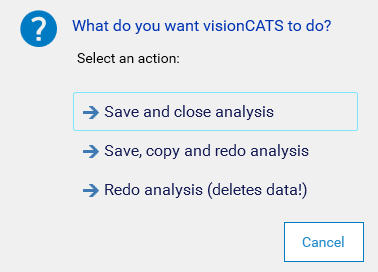
Important
Missing instrument diagnostics: if no valid instrument diagnostics were found for the selected instrument, a warning will be displayed when trying to start the step. It is advised to stop here (No), and then do the diagnostics before running the step. But it is also possible to continue to execute the step (Yes) without the diagnostics, at the risk that the missing instrument calibration may impact the results.
HPTLC PRO

With HPTLC PRO, it is not a single step, but a run of one or more step which are about to be executed. The instruction view therefore displays each step of the run, with the instruction for each HPTLC PRO Module.
Important
Unlike the other instruments, here the CAMAG® HPTLC PRO SYSTEM should be selected, not the HPTLC PRO Modules.
As the HPTLC PRO SYSTEM executes sequences, the Add to sequence button is displayed instead of Continue. Indeed, after adding it to a sequence, the HPTLC PRO SYSTEM supervisor should execute the run in a sequence, see Execution of a sequence.

If the selected HPTLC PRO SYSTEM includes a module PLATE STORAGE, the user must decide whether the carrier holding the plate should be placed in the clean or the processed stacker by configuring the The plate is clean? option. Note that visionCATS checks or unchecks this option by default, depending on the previous steps of the analysis. If the run contains a module APPLICATION step, visionCATS determines the vial positions for all compatible sequences. The user can choose in which sequence the run will be added and see an up-to-date state of the rack configuration. The software always offers the possibility to create a new sequence (last sequence in list).
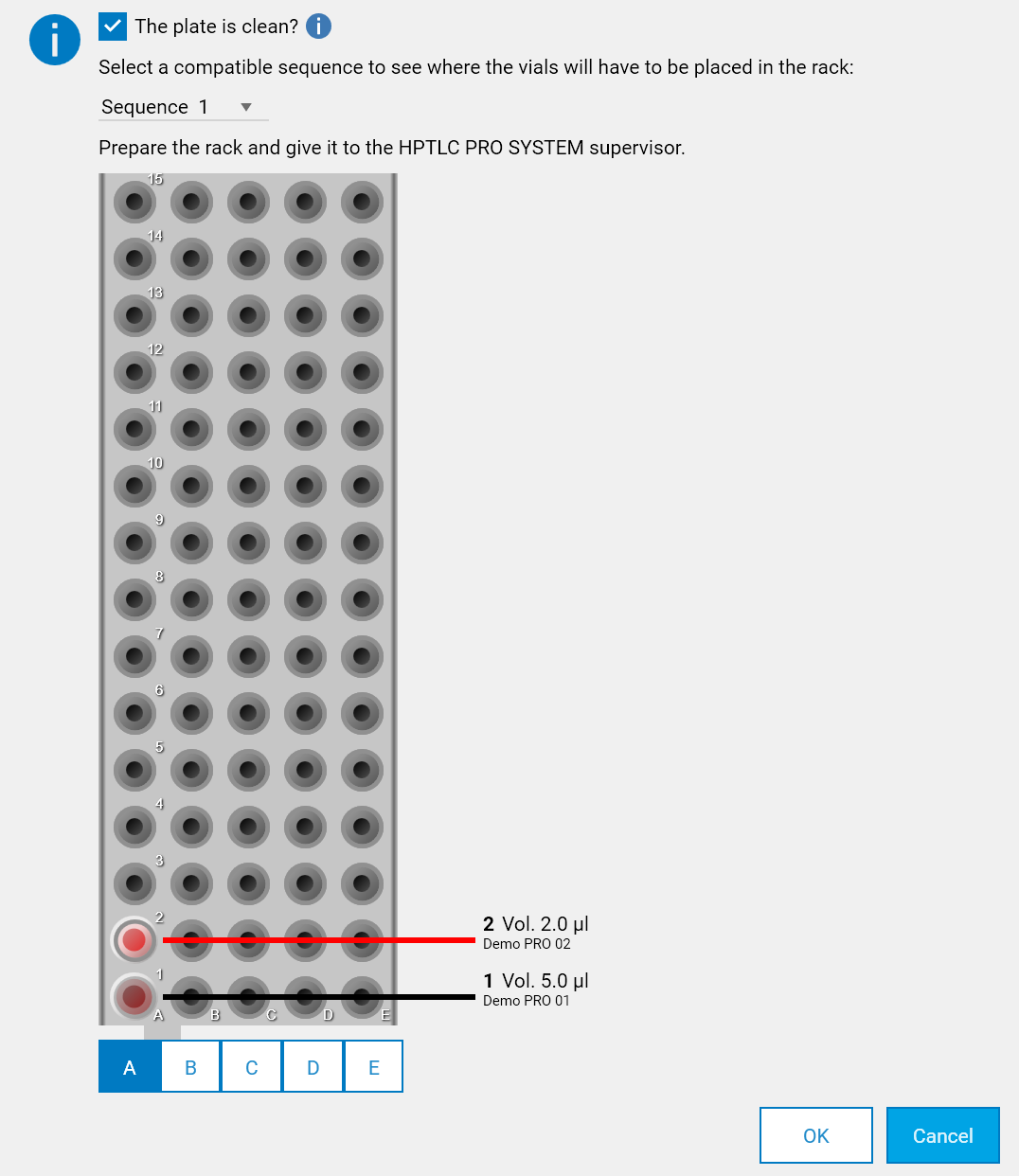
Note
If the selected sequence does not contain any application step, the rack is empty and so not shown.
An incompatible sequence is shown in italic and, if selected, a message explains the possible causes (sequence running, too many runs or consumables incompatibility).
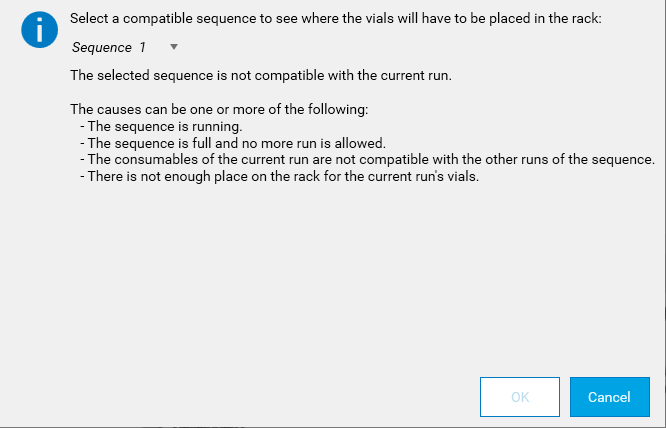
Then the HPTLC PRO SYSTEM supervisor will have to execute the sequences, see Execution of a sequence.
Execution display
With most instruments, you only need to wait for the end of the step before accepting it.
To give the user the possibility to correct obvious handling errors (plate placed the wrong way into TLC Visualizer, vial at the wrong position in ATS4, wrong plate in Scanner, etc.) before any data is in the system, it is possible to abort steps under the Options button. There are two choices:
Abort step
Undo step, save and close analysis
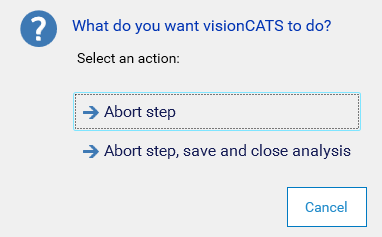
On both actions the HPTLC Logger shows the following:
Date and time of action
User that performed the action
Client (PC) where the action was performed
Information about the action (in the example below, the Image acquisition process of a TLC Visualizer was aborted)

Note
See Steps data loss and steps reexecution for more information about the available options and to understand how the aborts/interruptions are logged in visionCATS.
Common progression display
During the execution of a step, visionCATS displays progression information consisting in a progress bar, a current work status and the expected end time, whenever available:

Note
Progression of HPTLC PRO Runs is displayed differently. See HPTLC PRO.
Closing analysis during execution
Since visionCATS 3.2, it is also possible to close the whole analysis during the execution of an HPTLC instrument. That was previously only possible with HPTLC PRO. In both cases, at the end of the execution, the user will still have to accept or abort the step/run. The execution status will remain pending until the user reopens the analysis.
Application steps
Overall, the progression of the application of the tracks can become complex if the method/analysis defines several application steps, each one applying some vials on tracks which can have overspots. In order to follow the track application steps, visionCATS defines several colors:
Red: track(s) about to be applied with the Linomat 5 when it waits for the next sample
Very light gray: empty track
Light gray: track not applied
Light green: track partially applied (in case of multiple application steps with overspots)
Green: track fully applied
Gray: track to apply in the next step to execute
During step execution:
Orange (blinking): track being currently applied by the ATS 4/Linomat 5/APPLICATION module
Yellow green: track applied
In the following example, tracks with overspots were defined in an analysis with 2 Linomat 5 steps. At the beginning of the second step, the Linomat is waiting for the sample to apply at track 1, track 2 was partially applied during the first step, track 3 is not defined, track 4 was fully applied during the first step, and track 5 will be applied in the second step. The plate is therefore displayed as follows:
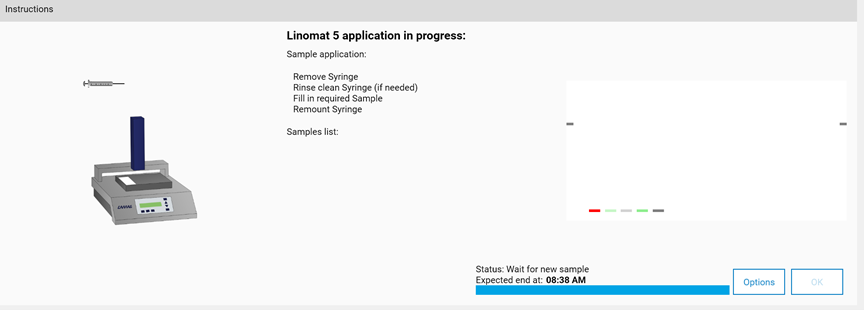
Data acquisition steps
But with data acquisition steps, the data should be validated (awaited images or profiles) before accepting:
TLC Visualizer
You can navigate between the images with the left and right buttons, and each image can be displayed in full size by clicking on it.
If an image sequence is programmed, it is possible to stop the capture midway with Finish (only already captured images would be used). Otherwise, wait for the capture of all images to finish and click on Accept all.
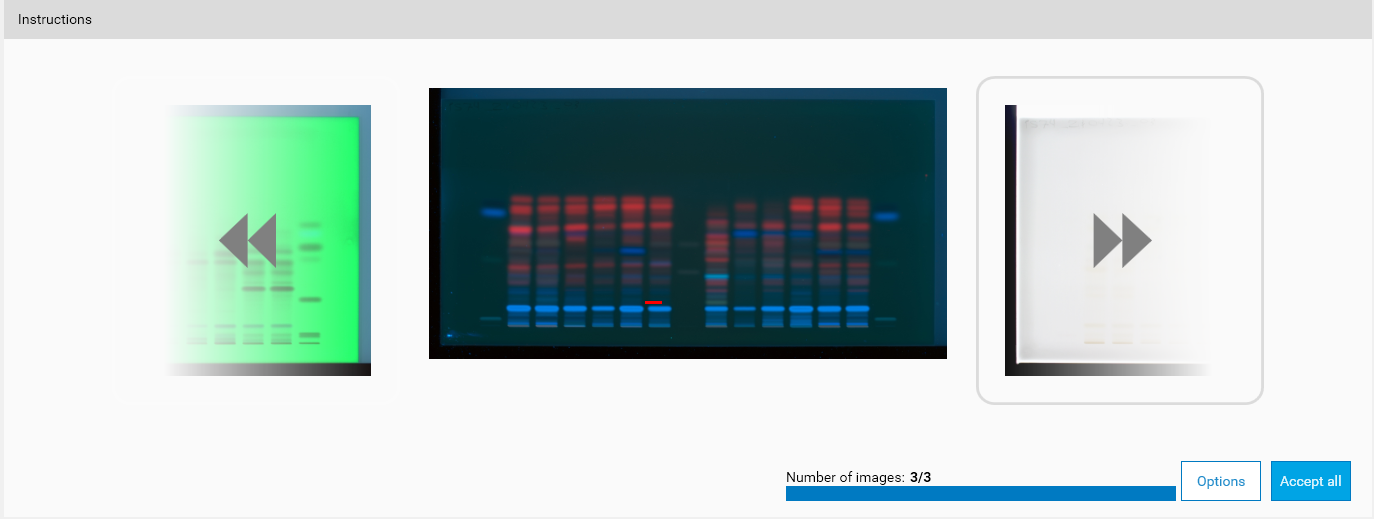
Note
The area used to determine the automatic exposure is displayed in red. If it isn’t on a track (plate defect…), the exposure may not be optimal.
Important
After accepting (or finishing), visionCATS will check the quality of each image, and display a warning if the quality is suboptimal.
When taking HDR images, the plate may be so dark (low fluorescence) that only the first image can be taken, the others would have an exposure time exceeding the camera specification or the global setting option (see TLC Visualizer (any version) max. exposure time for HDRI images). Therefore, the resulting image quality would be lower than in the normal case. It is then possible to abort the step to redo it under different conditions (like increasing the gain in manual exposure mode, or redoing the whole analysis because the plate fluorescence has decayed).
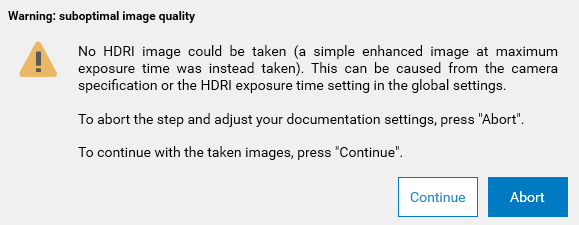
When clean plate images are available, Clean Plate Correction is available for all illuminations except R366. But if the plate is wrongly positioned, the correction may not be possible. It is recommended to re-position the plate before starting the capture again (in extreme conditions, the automatic correction may still not work).
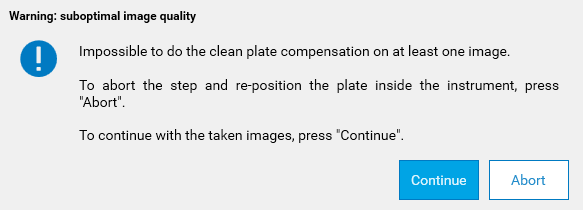
TLC Scanner 4
You can display the profile of each track. If they aren’t like awaited, it is better to abort the step, change the scanner parameters and restart the scanning.

HPTLC PRO
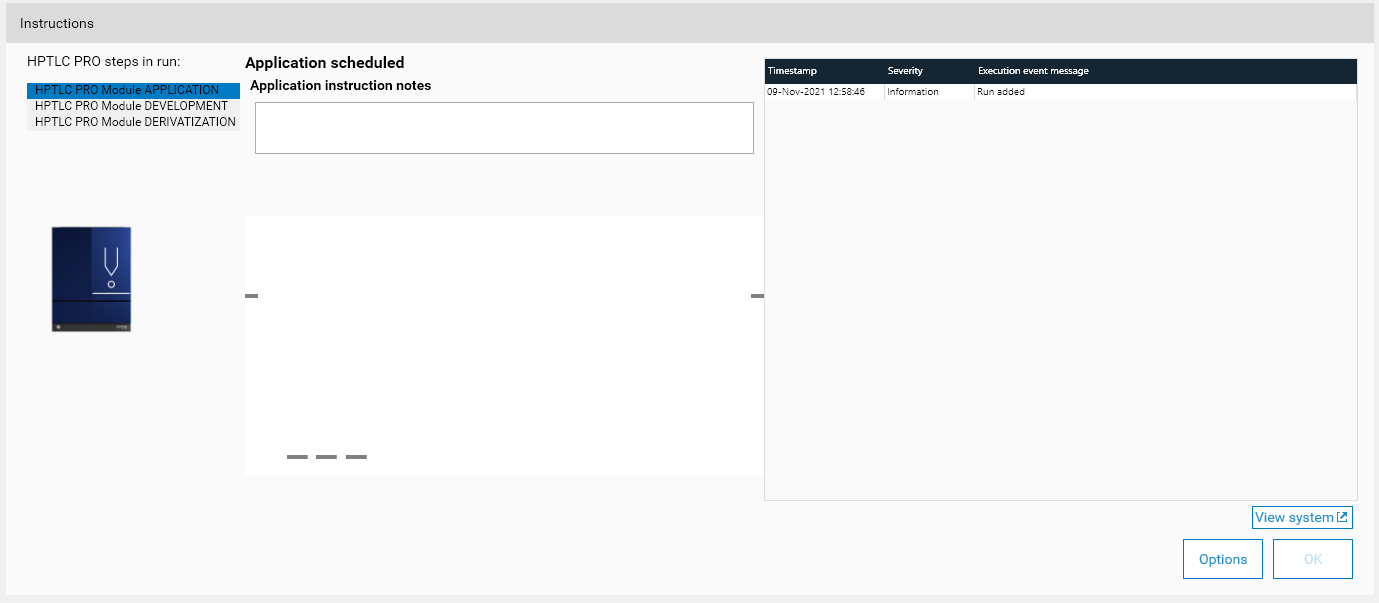
Any event message related to the run is displayed in the right table. The View system button will open the CAMAG® HPTLC PRO SYSTEM Details view.
On the left, the list of the different steps/HPTLC PRO Modules used in the run is visible. Selecting one will display its specific notes.
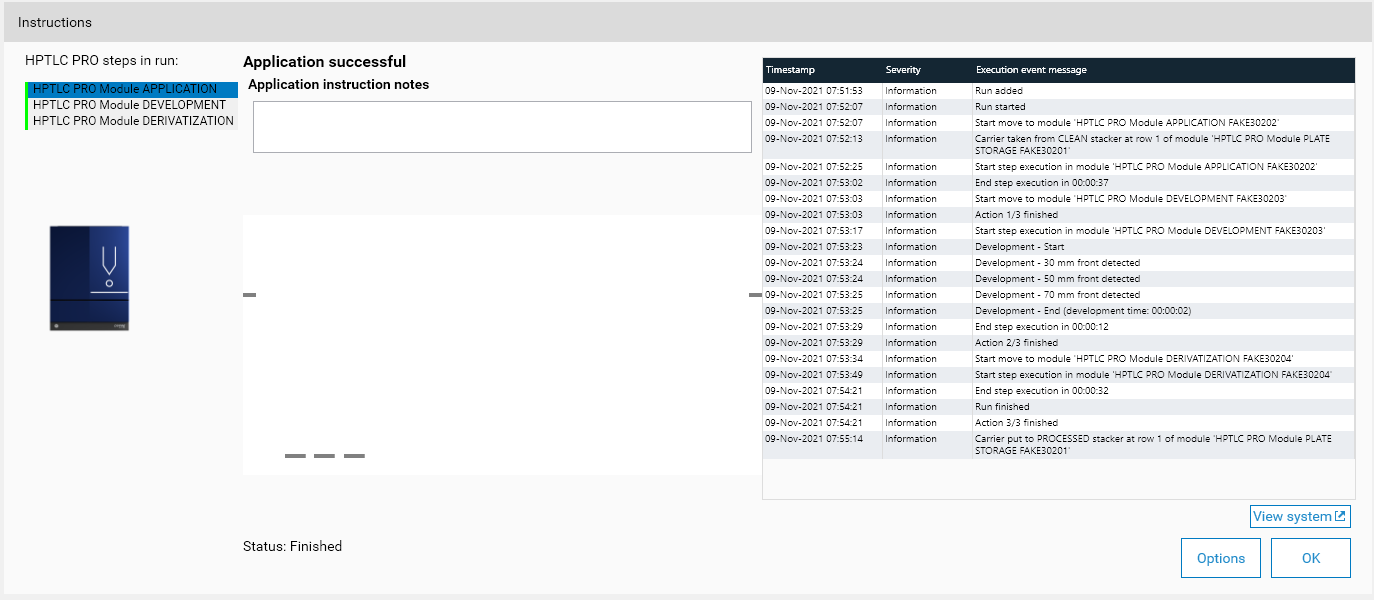
Analyses recovery
During a step execution, if visionCATS crashes (which should of course not happen), it is possible to recover the analyses which were running a step. When restarting visionCATS, the following popup appears to inform the user that they will be reopened.
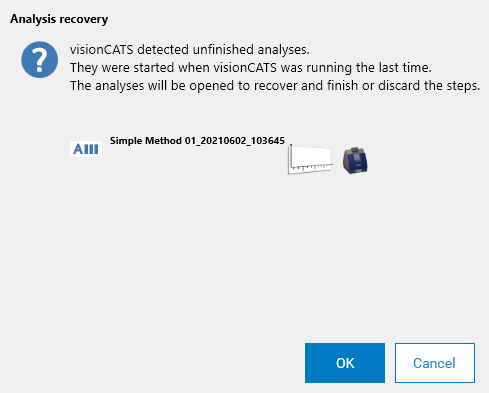
It is then possible to accept or abort the step.
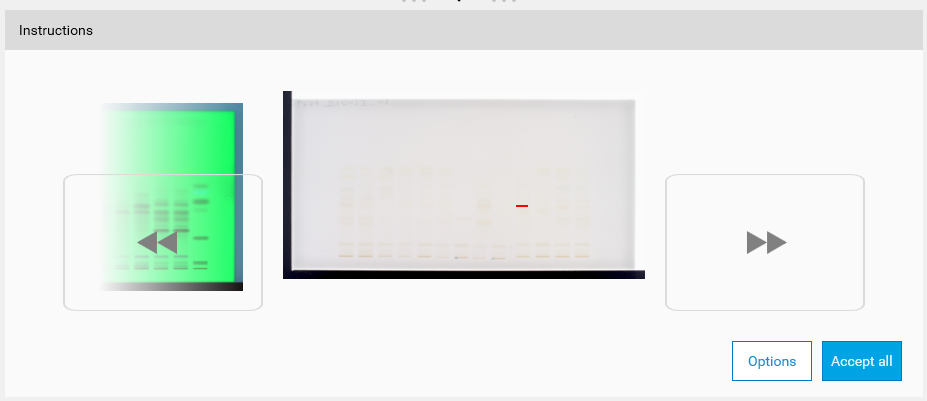
Note
To keep trace of the not nominal execution, a warning is displayed in the step’s info inside the report (Step was restored), and on several places in the analysis views.
